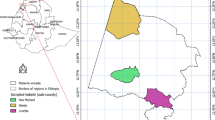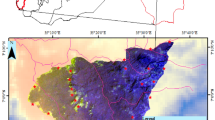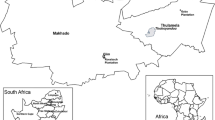Abstract
In India, Joint Forest Management (JFM) programme was first introduced in the year 1972 at Arabari forest range in West Bengal with the collaboration of local community and forest department for the protection of reserve forest and improvement of rural livelihood. Subsequently, in 1990 the JFM programme was further extended at nearby Bhadutola forest range of Paschim Medinipur (West Bengal, India). The evaluation of this programme with respect to ecological and economic indicators has not been done. The main objective of this study is to evaluate the effectiveness of JFM scheme in two sites and also assess the ecological impacts of such programs. Applying relevant research methods like focus group discussion (FGD), standard of living index (SLI), livelihood dependence index (LDI) and measurement of forest dependency, the effectiveness of JFM project has been assessed for the sustainable forest management. The ecological impacts were calculated using the value coefficient method through implied for ecosystem service functions. The results showed that the forest dwellers of Arabari forest range are getting more benefits like different non-timber forest products (NTFP) than Bhadutola forest range community. It is stated that around 85% respondents are highly satisfied with the implementation of JFM project. In the recent years, the standard of living index (SLI) of almost sixteen villages under JFM project has been significantly improved. The ecological impact for both the forest ranges clearly shows a positive effect on the ecosystem service values through food production, raw materials, genetic resources, climatic regulation and soil erosion control strategies. The Arabari forest range has shown more positive changes in ecological services function than the Bhadutola forest range. Therefore, this model needs to be applied effectively in different vulnerable forest ranges of tropical and sub-tropical regions of the world for sustainable forest resource conservation as well as improvement of livelihood of forest dwellers.



Similar content being viewed by others
References
Adhikari B (2005) Poverty, property rights and collective action: understanding the distributive aspects of common property resource management. Environ Dev Econ 10(1):7–31
Adhikary PP, Shit PK, Bhunia GS (2021) NTFPs for socioeconomic security of rural households along the forest ecotone of Paschim Medinipur forest division, India. Forest resources resilience and conflicts. Elsevier, Amsterdam, pp 239–246. https://doi.org/10.1016/B978-0-12-822931-6.00018-6
Ali A (2018) Forest-based livelihoods, income, and poverty: empirical evidence from the Himalayan region of rural Pakistan. J Rural Stud 57:44–54
Angelsen A, Jagger P, Babigumira R, Belcher B, Hogarth NJ, Bauch S, Wunder S (2014) Environmental income and rural livelihoods: a global-comparative analysis. World Dev 64:S12–S28
Appiah M (2001) Co-partnership in forest management: the Gwira-Banso joint forest management project in Ghana. Environ Dev Sustain 3(4):343–360
Bandi M (2015) Forest rights act in Chhattisgarh and Gujarat: unfolding the dynamics in implementation. J Rural Dev 34(2):135–147
Belcher B, Achdiawan R, Dewi S (2015) Forest-based livelihoods strategies conditioned by market remoteness and forest proximity in Jharkhand, India. World Dev 66:269–279
Bera B, Saha S, Bhattacharjee S (2020) Forest cover dynamics (1998–2019) and prediction of deforestation probability using binary logistic regression (BLR) model of Silabati watershed, India. Trees Fores People 2:100034
Bhattacharya P, Pradhan L, Yadav G (2010) Joint forest management in India: experiences of two decades. Resour Conserv Recycl 54(8):469–480
Bisui S, Roy S, Sengupta D, Bhunia GS, Shit PK (2021a) Conversion of land use land cover and its impact on ecosystem services in a tropical forest. Spatial modelling in forest resources management. Springer, Cham, pp 589–606. https://doi.org/10.1007/978-3-030-56542-8_25
Bisui S, Roy S, Sengupta D, Bhunia GS, Shit PK (2021b) Assessment of ecosystem services values in response to land use/land cover change in tropical forest. Forest resources resilience and conflicts. Elsevier, Amsterdam, pp 435–447. https://doi.org/10.1016/B978-0-12-822931-6.00031-9
Brown D, Malla Y, Schreckenberg K, Springate-Baginski O (2002) From supervising ‘subjects’ to supporting ‘citizens’: recent developments in community forestry in Asia and Africa. Nat Resour Perspect 75(4). https://www.files.ethz.ch/isn/91368/NRP75.pdf
Chamling M, Bera B (2020) Spatio-temporal patterns of land use/land cover change in the Bhutan-Bengal foothill region between 1987 and 2019: study towards geospatial applications and policy making. Earth Syst Environ 4:117–130. https://doi.org/10.1007/s41748-020-00150-0
Chatterjee ND, Das K (2017) Rational resource management and the role of traditional knowledge among the Santhal and the Bhumij Tribes of Binpur II Block, Paschim Medinipur, West Bengal. Nat Resour Manag Sustain Dev Rural Livelihoods 1:43–58
Costanza R, d’Arge R, De Groot R, Farber S, Grasso M, Hannon B, Limburg K, Naeem S, O’neill RV, Paruelo J, Raskin RG, (1997) The value of the world’s ecosystem services and natural capital. Nature 387(6630):253–260
Das N, Sarker D (2008) Distributional aspect of forest income: a study on JFM and non-JFM forest dependent households
Datta SK, Sarkar K (2010) Status of joint forest management in India: socio-economic determinants of forest participation in a dynamic optimization setting. Int J Soc For IJSF 3(2):81
Delgado TS, McCall MK, López-Binqüist C (2016) Recognized but not supported: assessing the incorporation of non-timber forest products into Mexican forest policy. For Policy Econ 71:36–42
Dolisca F, Carter DR, McDaniel JM, Shannon DA, Jolly CM (2006) Factors influencing farmers’ participation in forestry management programs: a case study from Haiti. For Ecol Manage 236(2–3):324–331
Dolui G, Chatterjee S, Chatterjee ND (2014) The importance of non-timber forest products in tribal livelihood: a case study of Santal community in Purulia district, West Bengal
FAO (2005) Global forest resources assessment progress towards sustainable forest management. Forest Paper, 147
FAO (2015) Global forest resources assessment 2015. How are the world's forests changing?
Fisher M (2004) Household welfare and forest dependence in southern Malawi. Environ Dev Econ 9(2):135–154
Guha A, Pradhan A, Mondal K (2000) Joint forest management in West Bengal: a long way to go. J Hum Ecol 11(6):471–476
Hill I, Shields D (1998) Incentives for joint forest management in India: analytical methods and case studies (Vol. 394). World Bank Publications, Washington
IIPS and Macro International (2000) National Family Health Survey (NFHS-2), 1998–99: India International Institute of Population Sciences, Mumbai
Iqbal M (2002) Socio-economic impacts of joint forest management in Mouza Fateh Bandi (Key area‐1), Siran forest division, Hazara. M.Sc. Forestry thesis. Pakistan forest institute, Peshawar
Jana SK, Lise W, Ahmed M (2014) Factors affecting participation in joint forest management in the West Bengal state of India. J For Econ 20(4):317–332
Kajembe GC, Luoga EJ (2006) The impact of community-based forest management and joint forest management on the forest resource base and local people’s livelihoods: Case studies from Tanzania
Kalumanga Olwig MF, Brockington D, Mwamfuge A (2018) Partnerships and governance in forest management in Tanzania: historical and current perspectives. Nepsus, Denmark, pp 1–31
Kamanga P, Vedeld P, Sjaastad E (2009) Forest incomes and rural livelihoods in Chiradzulu district, Malawi. Ecol Econ 68(3):613–624
Kar SP, Jacobson MG (2012) NTFP income contribution to household economy and related socio-economic factors: lessons from Bangladesh. For Policy Econ 14(1):136–142
Khosravi S, Maleknia R, Khedrizadeh M (2017) Understanding the contribution of non-timber forest products to the livelihoods of forest dwellers in the northern Zagros in Iran. Small-Scale For 16(2):235–248
Kindu M, Schneider T, Teketay D, Knoke T (2016) Changes of ecosystem service values in response to land use/land cover dynamics in Munessa-Shashemene landscape of the Ethiopian highlands. Sci Total Environ 547:137–147
Langat DK, Maranga EK, Aboud AA, Cheboiwo JK (2016) Role of forest resources to local livelihoods: the case of East Mau forest ecosystem, Kenya. Int J For Research 2016:1–10. https://doi.org/10.1155/2016/4537354
Lax J, Köthke M (2017) Livelihood strategies and forest product utilization of rural households in Nepal. Small-Scale For 16(4):505–520
Li RQ, Dong M, Cui JY, Zhang LL, Cui QG, He WM (2007) Quantification of the impact of land-use changes on ecosystem services: a case study in Pingbian County, China. Environ Monit Assess 128(1–3):503–510
Maraseni TN, Bhattarai N, Karky BS, Cadman T, Timalsina N, Bhandari TS, Apan A, Ma HO, Rawat RS, Verma N, San SM (2019) An assessment of governance quality for community-based forest management systems in Asia: prioritization of governance indicators at various scales. Land Use Policy 81:750–761
Maskey V, Gebremedhin TG, Dalton TJ (2006) Social and cultural determinants of collective management of community forest in Nepal. J For Econ 11(4):261–274
Mukherjee P, Ray B, Bhattacharya RN (2017) Status differences in collective action and forest benefits: evidence from joint forest management in India. Environ Dev Sustain 19(5):1831–1854
Mukul SA, Rashid AM, Uddin MB, Khan NA (2016) Role of non-timber forest products in sustaining forest-based livelihoods and rural households’ resilience capacity in and around protected area: a Bangladesh study. J Environ Plan Manag 59(4):628–642
Nagendra H (2002) Tenure and forest conditions: community forestry in the Nepal Terai. Environ Conserv 29(4):530–539
Nath TK, Jashimuddin M, Inoue M (2020) Achieving sustainable development goals through participatory forest management: examples from south-eastern Bangladesh. Nat Resour Forum 44(4):353–368
Pandey AK, Tripathi YC, Kumar A (2016) Non timber forest products (NTFPs) for sustained livelihood: challenges and strategies. Res J For 10(1):1–7
Phiri M (2009) Evaluation of the performance of joint forest management (JFM) programme: case of Dambwa Forest Reserve in Livingstone district, Zambia, doctoral dissertation, Stellenbosch: University of Stellenbosch
Pradhan P, Singh M (2019) Role of non-timber forest products (NTFPs) in sustaining forest-based livelihoods: a case study of Ribdi village of West Sikkim. India. Indian J Tradit Knowl 18(3):595–609
Rahut DB, Behera B, Ali A (2016) Do forest resources help increase rural household income and alleviate rural poverty? Empirical evidence from Bhutan. Fores Trees Livelihoods 25(3):187–198
Ravindranath NH, Sudha P (2004) Joint forest management in India: spread, performance and impact. Universities Press, India, pp 86–121
Rawat TS, Menaria BL, Dugaya D, Kotwal PC (2008) Sustainable forest management in India. Curr Sci 94(8):996–1002
Ros-Tonen MA, Wiersum KF (2003) The importance of non-timber forest products for forest-based rural livelihoods: an evolving research agenda. In GTZ/CIFOR international conference on livelihoods and biodiversity, Bonn, Germany
Saha M, Sengupta S (2014) Symbiotic relationship between forest and tribe: a case study of Santal Tribe of Jaypur Forest, Bankura District, West Bengal, India. Transactions 36(2):235–246
Schmerbeck J, Kohli A, Seeland K (2015) Ecosystem services and forest fires in India—context and policy implications from a case study in Andhra Pradesh. Forest Policy Econ 50:337–346
Sheikh Y, Ibrar M, Iqbal J (2019) Impact of joint forest management on rural livelihoods in the Kalam and Siffran forest divisions, Khyber Pakhtunkhwa Pakistan. Glob Reg Rev 4:225–237
Shit PK, Pati CK (2012) Non-timber forest products for livelihood security of tribal communities: a case study in Paschim Medinipur district, West Bengal. J Hum Ecol 40(2):149–156. https://doi.org/10.1080/09709274.2012.11906533
Sukhdev P (2009) Costing the earth. Nature 462(7271):277
Vedeld P, Angelsen A, Bojö J, Sjaastad E, Berg GK (2007) Forest environmental incomes and the rural poor. Forest Policy Econ 9(7):869–879
Wily LA (2002) Participatory Forest Management in Africa: An Overview of Progress and Issues. A Key Note Paper Presented in the Second International Workshop in Participatory Forestry in Africa, Arusha, Tanzania, pp 18–22
Wollenberg E (1999) Methods for assessing the conservation and development of forest products. Incomes from the forest. CIFOR, Indonesia, pp 1–16
Wunder S, Angelsen A, Belcher B (2014) Forests, livelihoods, and conservation: broadening the empirical base. World Dev 64(1):S1–S11
Acknowledgements
The authors are extremely grateful to all those participating in the research, especially the community members of the villages of Paschim Medinipur District. We are grateful to the PG Department of Geography, Raja N. L. Khan Women’s College (Autonomous), affiliated to Vidyasagar University, Midnapore, West Bengal, India for supporting this research. The author (P. K. Shit) grateful acknowledges West Bengal DSTBT for financial support through R&D Research Project Memo no. 104 (Sanc.)/ST/P/S&T/ 10G-5/2018).
Funding
This research did not receive any specific grant from funding agencies in the public, commercial, or not-for-profit sectors.
Author information
Authors and Affiliations
Corresponding author
Ethics declarations
Conflict of interest
The authors declare no conflict of interest.
Rights and permissions
Springer Nature or its licensor holds exclusive rights to this article under a publishing agreement with the author(s) or other rightsholder(s); author self-archiving of the accepted manuscript version of this article is solely governed by the terms of such publishing agreement and applicable law.
About this article
Cite this article
Bisui, S., Roy, S., Bera, B. et al. Economical and ecological realization of Joint Forest Management (JFM) for sustainable rural livelihood: a case study. Trop Ecol 64, 296–306 (2023). https://doi.org/10.1007/s42965-022-00275-5
Received:
Revised:
Accepted:
Published:
Issue Date:
DOI: https://doi.org/10.1007/s42965-022-00275-5




